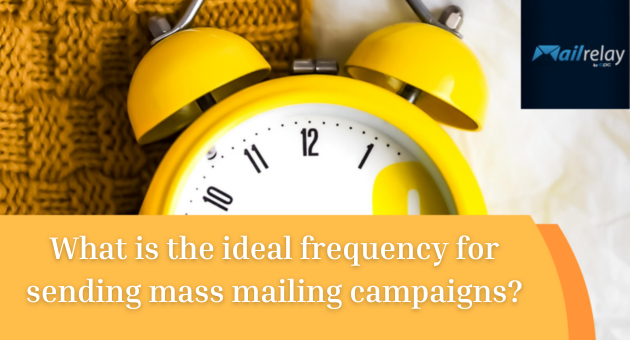
Sending emails is a strategy used by companies and professionals all over the world with their own businesses. And, not surprisingly, it brings excellent results, regardless of the sector in which it is implemented.
Email is a direct means of communication and information, which reinforces the brand image, promotes customer loyalty, contributes to increased sales and allows you to generate a positive impact on business, saving time and money.
In addition to all its advantages, one of the aspects that generates the most doubts when implementing a strategy of this type is precisely the correct sending frequency.
We can find very different (and even contradictory) statements on this aspect, as it all depends on the perspective of the business in question. So, in this article, we’ll talk about what is the ideal frequency for sending mass mailing campaigns, or rather, what is the best, depending on the type of business.
To find out what is the best frequency for sending mass mailing campaigns, you should analyze different criteria for your company, as this can vary according to the nature of your business.
Criteria for determining the best sending frequency
The first thing you should understand is that there is no universal frequency for sending campaigns or, in other words, one that is equally effective for all businesses or companies.
That said, I recommend that you take note of some of the criteria that can influence the sending frequency.
In this sense, you should analyze each of these criteria to adapt them to your particular circumstances, in order to make the right decision and thus work later on possible optimization and improvement of results.
It’s important to emphasize that sending mass mailing campaigns is not the same as sending newsletters. These formats have different objectives and therefore their sending frequencies should also be different.
The purpose of sending a mass mailing campaign
First of all, the sending frequency is determined by the purpose of the message. Among these, we can distinguish objectives such as the following ones:
- To launch a new product or service.
- Discounts or promotions for a limited time.
- Loyalty offers.
- Selling tickets.
In the case of promotions, the sending frequency will depend on their duration. For example, a Christmas promotion (which can last 3 weeks or even a month) is not the same as a Book Day promotion:
* Sending frequency for a Christmas promotion. In this case, the frequency would be lower, but more spaced out over time (for example, two emails a week at most).
* Frequency for sending a mass mailing campaign for a Book Day promotion. As the duration is shorter, the frequency can be increased (e.g. one email a day during a week).
It should also be noted that in the case of newsletters, whose purpose is not purely promotional, it is possible (and even advisable) to increase the sending frequency. After all, we’re talking about newsletters that are relevant to their recipients.
The profile of the subscriber database
Another element that can influence the frequency with which campaigns are sent is the average profile of the subscribers in the database. In this respect, it’s important to differentiate between professional and personal profiles. By this I mean two aspects:
- Firstly, it is essential to distinguish between B2B and B2C businesses. The former are aimed at companies and the latter at end consumers.
- In addition, you should check your database to detect whether emails are from corporate or personal accounts (e.g. gmail).
This can provide you with important information about the sending frequency. For example, if they are mainly corporate emails, the frequency should be adapted to business hours. But if they are personal, messages can be sent at other times.
In addition to all this, you should analyze the metrics of previous mailings to draw up a more precise user profile. You’ll probably find patterns that can help you determine a more appropriate sending frequency.
The tool for sending mass mailing campaigns
If we look at the issue from a technological point of view, we must refer to the different tools on the market for sending mass mailing campaigns. The nature of these tools will also influence the sending frequency.
Ideally, you want to work with a tool that allows you to send a lot of messages quickly, but also offers options for scheduling emails for specific dates.
Mailrelay meets both of these conditions. On the one hand, the free account allows you to send up to 80,000 emails a month. On the other hand, it includes an option to schedule mailings (even for the free plan).
In addition, using the free account, you can enjoy advantages such as:
- It includes an easy-to-use visual editor for creating professional emails without technical knowledge.
- It allows you to work with a database of up to 20,000 contacts.
- There are no daily sending limitations, so it won’t affect your frequency.
- It offers technical support.
All of this is extremely important, as not all tools on the market offer this flexibility on free accounts. So check the features and packages offered by all of them before choosing one.
Mailrelay is the only tool on the market that offers 80,000 emails per month in its free account. It also includes premium features without the need to enter bank details.
Sending statistics
Statistics from previous campaigns will tell you how users acted when they received your messages. In other words, you can analyze what the ideal sending frequency is, for example, according to open rates.
If you discover that they are a loyal audience and open every email you send, regardless of the quantity, you may be able to increase the frequency.
If, on the other hand, you realize that the number of messages sent is affecting the number of unsubscribe requests or that they are not reading all the newsletters, it would be better to reduce the frequency.
Seasonality of the business
Another aspect to consider is the seasonality of your product or service. In other words, do you offer a product or service that can be consumed all year round or do you offer a specific offer for certain months?
An example of this can be seen in stores selling swimwear. This type of product is usually bought more during the summer. Therefore, the sending frequency during the rest of the year should be low, while it should increase in the warmer months.
In short, it’s better to invest time and effort when the customer is really willing to buy.
If you send the same type of campaigns every month, I recommend that you analyze the above metrics to establish a sending frequency that is adjusted to the needs of your audience.
Available resources
Finally, the sending frequency will also be conditioned by the resources you have available. In other words, whether you have the financial and human resources to devote to this task. It is understood that with more resources, you are more likely to be able to create professional, conversion-optimized emails.
On the other hand, if your resources are limited, it is preferable to send emails less frequently, but that those you do send meet the above conditions. Otherwise, your audience will end up unsubscribing from your list.

A newsletter, unlike a mass mailing campaign, has a less commercial and more informative purpose. This means that it can be sent more frequently.
A newsletter is a very powerful indirect sales tool. Although it is not its main objective, its content helps enormously to win customers through user loyalty.
In this sense, there are those who prefer to send a single weekly email and those who prefer to send a daily one. Some of the considerations you should take into account before defining the frequency of your newsletters are:
- Strategy. Do you have a strategy? Any step you take in the marketing world must be backed up by a coherent strategy. If it suggests a high frequency rate, you should go for it (and vice versa).
- Can you create several relevant emails every week? Sending an email every day and being sure that your target audience will be interested in it is highly unlikely. Therefore, if you can’t create a large number of engaging emails, it would be better to reduce the sending frequency. We have a responsibility to ensure that users don’t become disenchanted with email marketing.
- Audience acceptance. This point is linked to the previous one. If users like your newsletters and interact with them, go ahead and increase the frequency. But if less subscribers are interacting with the emails as you send more, stop!
Any action you take in your email marketing strategy, especially if you decide to send mass mailing campaigns, must be well thought out and backed up by statistical data. It’s best not to improvise, as the results could be compromised.
With regard to the question of when is the best time to send a newsletter, there are very different opinions in the sector.
- Many people say the ideal time is from Tuesday to Thursday, first thing in the morning or late afternoon.
- According to some sources, on Mondays we don’t pay much attention to non-urgent emails. In other words, we concentrate on those messages that were left over from Friday or those we received over the weekend asking for something important.
- On Fridays, we can’t wait to turn off the computer, as we just want to disconnect and rest. And this indicates that it’s not a good day to send newsletters either.
- As for weekends, we seem to be less inclined to read emails. So it’s best not to send a newsletter on these dates.
But is it true? In my opinion, before taking any statement for granted, the ideal thing is to check what your audience’s preferred time of day is.
To do this, you should test your database. You might be surprised! The time of day can vary according to the users you target, the type of newsletter you send, the countries you work with, your sector…
With regard to the latter, imagine that you organize family events in the countryside. Don’t you think it would be better to send your newsletter during the weekend? With Mailrelay you can easily run this kind of test and measure the results. This data is what will really tell you the best time to send a newsletter.
So… is there an ideal sending frequency?
As you may have deduced, there is no standard frequency for all companies or projects. It is therefore advisable for everyone to establish their own, based on criteria such as those described in this article.
If it’s the first time you’re tackling this kind of task, as I said about the newsletter schedule, the best thing to do is run tests to check your audience’s reaction.
Remember that not all people behave in the same way when confronted with a mailing. Some people don’t mind receiving emails with high frequency, but others may find it annoying.
In addition, you should analyze how to get better metrics from your emails. In other words, what kind of frequency helps you get the best results. This is perhaps the most important factor of all 😉
In any case, I recommend that you test the frequency of your mailings with your own database. Without a doubt, email is still one of the best digital channels for talking to your subscribers and, why not, potential customers!
